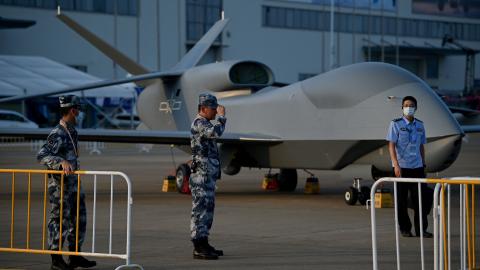Xi Jinping, at the 20th National Congress of the Chinese Communist Party (CCP) on October 16, stated that China will more quickly elevate the People’s Liberation Army (PLA) to a world-class military.
Throughout human history, new military technologies have changed the balance of power in the world. In Eurasia in the 2nd millennium B.C., the chariot was the dominant weapon, and counties that possessed it retained overwhelming military power. Then, after a long period of cavalry dominance, gunpowder transformed the political and military landscape. Gunpowder elevated the position of musketeers and degraded that of cavalry. It also changed the balance of power between fortifications and siege weapons, weakening the power of city-states. In 1453, cannons brought down the incomparable walls of Constantinople.
In the 21st century, the balance of power may shift as nations using advanced artificial intelligence acquire dominant military power. Artificial intelligence enhances or replaces the human brain. Weapons developed in previous human history have enhanced human muscles, eyes, and ears. Compared to primitive humans, modern humans have acquired powerful killing power and are able to see their enemies thousands of miles away and communicate with their allies thousands of miles away. But for the first time in the long history of human warfare, the brain is being enhanced. The changes brought about by artificial intelligence will therefore be unprecedented and distinctive in the history of humankind.
China intends to use artificial intelligence to build a world-class military. Xi Jinping, at the 20th National Congress of the Chinese Communist Party (CCP) on October 16, stated that China will more quickly elevate the People’s Liberation Army (PLA) to a world-class military. At the 19th Party Congress in 2017, Xi insisted China would build a world-class military by the middle of this century; this time he did not mention a definite deadline but clearly stated that he would achieve the goal more quickly.
In addition, Xi Jinping mentioned the word “intelligent” (智能化) three times. The concept of “intelligent,” which refers to the use of weapon systems based on artificial intelligence, has rapidly gained attention since the release of the 2019 National Defense White Paper. Chinese researchers insist that the PLA can overtake the U.S. military through the use of artificial intelligence for the intelligentization of the PLA.
Intelligentization, which refers to the use of artificial intelligence, has become the focus of China's military reform. Xi said in the last year’s congress that China would adhere to the integrated development of the PLA through mechanization, informatization, and intelligentization. At the 19th Party Congress in 2017, Xi referred to mechanization and informatization. Intelligentization was added to this list at last year’s congress. This indicates that the concept of intelligentization, which has developed rapidly since 2019, has been accepted into China’s national defense policy and that the national leadership has expressed its willingness to promote it.
Will this reform in China be feasible? Above all, the Biden administration's October 7, 2022 announcement of broad semiconductor regulations will be a major obstacle to China's development of artificial intelligence. The regulations will hinder the sale of high-end chips for AI and supercomputing to China. Semiconductors are the Achilles heel of China's economy, with Chinese factories relying on imports for 85% of the microchips needed to make electronic products. Given that the focus of China's military buildup is artificial intelligence, this regulation of semiconductors would be therefore highly effective.
The semiconductor supply chain is complex and changes over time, and the United States does not have control over all of it. However, the United States has strong alliances and partnerships with most of the world's key players in semiconductor manufacturing. It would be extremely difficult for China to replicate the technologies of all these countries in the short term. If it is difficult for China to obtain cutting-edge semiconductors, PLA's intelligentization will not realize, and the construction of a world-class army may fail.
However, advanced military power depends not on the superiority of the technology itself, but on the advanced operational theory of using the new technology. For example, Germany's quick victory over France at the beginning of World War II was due to Germany's innovative concept of the Blitzkrieg. Although France possessed a greater number of tanks with better performance than Germany, the French operational theory had not changed since World War I, treating tanks as support weapons for infantry. And France was unable to cope with the blitzkrieg assault from the Ardennes Forest by German armored divisions composed of tanks.
Similarly, in the Franco-Prussian War of 1870, Prussian Chief of Staff Helmuth von Moltke used new railroad technology to win a victory over the French by dispersing numerous troops and maneuvering them simultaneously to come together near the target. However, the railroad technology of the losing side, France, was superior to that of Prussia. Thus, what is important is not the superiority of the technology itself, but the superiority of the operational concept. For this reason, it is necessary to pay attention to how China intends to use artificial intelligence.
Papers that have been published so far by PLA senior officials and strategists show that the PLA is seeking to use artificial intelligence in four main areas. One is the autonomy of unmanned weapons, including the development of swarms of numerous drones. China aims to conduct highly autonomous integrated operations with a variety of unmanned systems and unmanned weapons. In addition, the PLA is rapidly expanding its use of unmanned weapons, first entering the airspace south of Taiwan's ADIZ in September 2022 with the number of intrusions increasing to a total of 70 by December.
The second is processing large amounts of information through machine learning. For example, the PLA is building a network of unmanned weapons and undersea sensors in the waters surrounding China and is attempting to process information obtained from this network using artificial intelligence. In addition, the PLA is considering a new form of electronic warfare that uses artificial intelligence to analyze received radio waves and optimize jamming.
The third is the use of artificial intelligence to speed up military decision-making. In the United States, studies point out that the use of artificial intelligence for decision-making, such as those involving nuclear strategy, has raised the risk of “flash wars,” in which conflicts escalate instantaneously. In China, too, there is debate over the extent to which decision-making should be entrusted to artificial intelligence in light of these dangers. For the time being, therefore, rather than delegating complex decision-making to artificial intelligence, it is likely that China will utilize artificial intelligence for simple tasks such as information processing and autonomous weapons.
These three are common arguments for new ways of fighting using artificial intelligence in the United States, such as mosaic warfare and decision-centered warfare. The unique argument in China is the idea of using artificial intelligence in cognitive warfare.
Cognitive warfare is influencing the cognition of the human brain and the will of the opponent to create a strategically favorable environment or subdue the opponent without a fight. In China, there is an active debate about cognitive warfare. For example, Qi Jianguo, former deputy chief of staff of the PLA, has stated that those who gain the upper hand in developing new-generation artificial intelligence technologies will be able to control the lifeline of national security: human cognition. Li Minghai of China's National Defense University also argues that cognitive warfare will be the main battleground for future wars.
Thus, China is engaged in a wide range of military applications of artificial intelligence as well as an extensive discussion of its potential uses. In using artificial intelligence to win wars, the technology itself does not necessarily have to be state-of-the-art. In 1940, Germany defeated France in only 42 days, thanks to the innovative concept of blitzkrieg using tanks. At that time, only a few percent of the German army was mechanized, the bulk of the German army was still an obsolete force dependent on horses and foot soldiers, and the tanks were less capable than the French.
Therefore, while competition to develop the latest technology is important, an approach that focuses only on the technical aspects of the performance of new technologies and the extent of their implementation is not appropriate. China is actively discussing new ways to fight using artificial intelligence. The United States and its allies should not lose the race to develop new ways of fighting using new technologies.




















